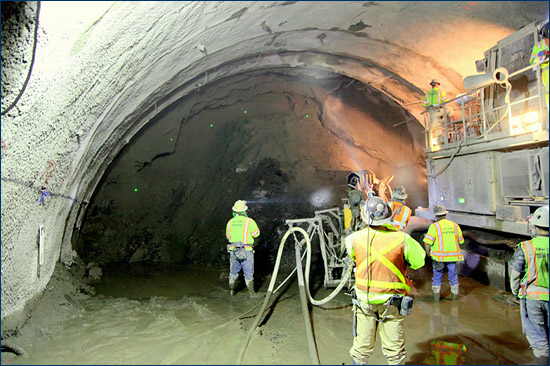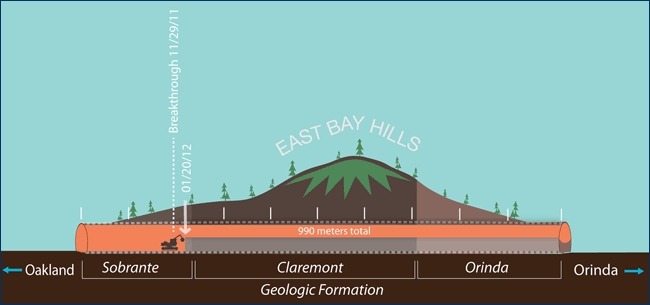
A November 2011 photo of workmen drilling a fourth bore of the Caldecott Tunnel.
Got fossils? — a UCMP/Caltrans agreement in the works
by Mark Goodwin
 A November 2011 photo of workmen drilling a fourth bore of the Caldecott Tunnel. |
Driving to and from Oakland and Orinda along Highway 24 during the past year, you cannot help but notice the steeply tilted, folded, and faulted sedimentary rocks on either side of the roadway, particularly on the east side of the Caldecott tunnel in Orinda. Also visible are the massive ventilation ducts, retaining walls, trucks and heavy equipment required to punch through the new fourth bore of the Caldecott tunnel currently under construction — a huge undertaking!
Fortunately for the UC Museum of Paleontology, the rocks being tunneled were formed between nine and 16 million years ago, and the excavation is yielding a variety of vertebrate, invertebrate, plant, and microfossils. The "Fourth Bore J project" provides an unprecedented opportunity for UC scientists to restudy these formations and recover thousands of new fossils, which will become part of our permanent collections. This is the result of a pending one-year agreement between the California Department of Transportation (Caltrans) and the UCMP, which will provide the necessary funding to hire a UCMP preparator, support our graduate and undergraduate students, and purchase curation and preparation supplies and equipment required to properly conserve, curate and catalog this important scientific resource. Additionally, support for outreach and education activities related to the scientific significance of the recovered fossils and the tunneling project is planned.
 This graphic shows tunnel progress as of January 23, 2012. |
 Sixty-five boxes of Caldecott Tunnel fossils are now stored in UCMP space at the Regatta facility in Richmond. |
Drilling crew photo courtesy of Caltrans, District 4; tunnel graphic courtesy of Caltrans; boxes photo by Mark Goodwin